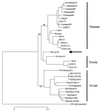Characterization of the 1918 "Spanish" influenza virus neuraminidase gene
- PMID: 10823895
- PMCID: PMC18739
- DOI: 10.1073/pnas.100140097
Characterization of the 1918 "Spanish" influenza virus neuraminidase gene
Abstract
The "Spanish" influenza pandemic of 1918 was characterized by exceptionally high mortality, especially among young adults. The surface proteins of influenza viruses, hemagglutinin and neuraminidase, play important roles in virulence, host specificity, and the human immune response. The complete coding sequence of hemagglutinin was reported last year. This laboratory has now determined the complete coding sequence of the neuraminidase gene of the 1918 virus. Influenza RNA fragments were isolated from lung tissue of three victims of the 1918 flu; complete sequence was generated from A/Brevig Mission/1/18, with confirmatory sequencing carried out on A/South Carolina/1/18 and A/New York/1/18. The 1918 neuraminidase gene sequence was compared with other N1 subtype neuraminidase genes, including 9 N1 strains newly sequenced for this study. The 1918 neuraminidase shares many sequence and structural characteristics with avian strains, including the conserved active site, wild-type stalk length, glycosylation sites, and antigenic sites. Phylogenetically, the 1918 neuraminidase gene appears to be intermediate between mammals and birds, suggesting that it was introduced into mammals just before the 1918 pandemic.
Figures



References
Publication types
MeSH terms
Substances
Associated data
- Actions
- Actions
- Actions
- Actions
- Actions
- Actions
- Actions
- Actions
- Actions
- Actions
LinkOut - more resources
Full Text Sources
Other Literature Sources

